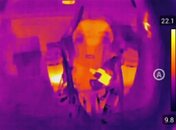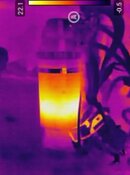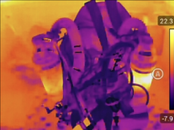As a new Sidewinder diver I was intrigued by the exothermic process of the sofnolime and was wondering if this could be some sort of a quick reference / sanity check for the consumption of the scrubber. Just using my (cold, post-dive in 14C water and 10C air) hands it was easily noticeable that the scrubber cannisters were not uniform in temperature. Not having the syntactic foam makes this easier to feel. Knowing that the rEvo uses a tempstick on the inside during a dive, I tried to do something similar after the dive to get at least some feeling for scrubber consumption.
I got a GuideIR thermal camera available due to other reasons (installation/inspection of heating systems), so it would be easy to get some images. The first measurement I made is after 3,5h (1+1.5+1h) of diving 13-15C water and the second measurement is after a total runtime of 5:20h.
I'm not planning on pushing the scrubber for longer using this method, however it can prove valuable to have a quick sanity check after a dive. If I'd feel/see a hot spot on the inhale scrubber after just a limited amount of use, I'd be more tempted to just bin the whole contents.
Anyway, pictures!
The first picture shows 3,5h of use. The second a closeup of the exhale cannister. The 3rd picture is after another dive with total scrubber use of 5:20h. A fairly defined hot zone is visible first on the left/exhale side and another dive (of 1:50h) later this has moved to the right/inhale side. All pictures are within 5min of exiting the water and at similar temperature conditions. After the last dive the WOB was noticeably higher and the sorb was moist almost all the way to the inhale side.



Anyone else got some experience on the usability of this method and/or has good reasons to fully ignore this? There is of course a risk of misjudging channeling along the colder outside of the cannisters as 'passive' heat, so I have no intent to use this data to push my stack time to its limits. It might however give a nice confirmation of the expected use rate of the sorb over time
There is of course a risk of misjudging channeling along the colder outside of the cannisters as 'passive' heat, so I have no intent to use this data to push my stack time to its limits. It might however give a nice confirmation of the expected use rate of the sorb over time
(Also see: The imbalance of CO2 absorption of the rebreather scrubber)
I'll gather some more data in the next couple of months to see how the peak heating zone corresponds with visual changes in the sorb moisture lever / coloring when emptying the cannisters.
I got a GuideIR thermal camera available due to other reasons (installation/inspection of heating systems), so it would be easy to get some images. The first measurement I made is after 3,5h (1+1.5+1h) of diving 13-15C water and the second measurement is after a total runtime of 5:20h.
I'm not planning on pushing the scrubber for longer using this method, however it can prove valuable to have a quick sanity check after a dive. If I'd feel/see a hot spot on the inhale scrubber after just a limited amount of use, I'd be more tempted to just bin the whole contents.
Anyway, pictures!
The first picture shows 3,5h of use. The second a closeup of the exhale cannister. The 3rd picture is after another dive with total scrubber use of 5:20h. A fairly defined hot zone is visible first on the left/exhale side and another dive (of 1:50h) later this has moved to the right/inhale side. All pictures are within 5min of exiting the water and at similar temperature conditions. After the last dive the WOB was noticeably higher and the sorb was moist almost all the way to the inhale side.



Anyone else got some experience on the usability of this method and/or has good reasons to fully ignore this?
(Also see: The imbalance of CO2 absorption of the rebreather scrubber)
I'll gather some more data in the next couple of months to see how the peak heating zone corresponds with visual changes in the sorb moisture lever / coloring when emptying the cannisters.



